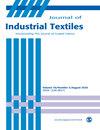基于简化有限元法的经编间隔织物压缩行为
IF 2
4区 工程技术
Q1 MATERIALS SCIENCE, TEXTILES
引用次数: 0
摘要
经编间隔织物(WKSF)具有独特的结构和优异的能量吸收性能,被广泛应用于汽车工业、医疗领域和航空航天领域。然而,在实际应用过程中,WKSF 会受到反复压缩,这可能会导致间隔纱产生压缩疲劳,进而导致 WKSF 发生不可逆变形,进而影响其性能和外观。因此,为了提高 WKSF 的抗压性能并研究塑性破坏的机理,本研究使用经编双针棒拉舍尔机制造了厚度为 20 毫米的 WKSF。通过织物结构分析,我们建立了一个由 32 根纤维组成的单元格模型和一个由 320 根纤维组成的更全面的分析模型,以定量评估 WKSF 在压缩过程中的几何变化。此外,我们还通过实验研究了 WKSF 在不同压缩速度、不同压缩应变和 1000 次循环加载下的性能变化。通过将实验测试与有限元方法相结合,我们对 WKSF 的压缩过程进行了深入研究,模拟了压缩过程中的位移 U、Von Mises 应力分布和塑性压缩破坏行为。通过比较 Von Mises 应力、等效塑性应变 (PEEQ) 和能量密度分布 (SENER) 等数据,我们可以清楚地观察到间隔纱在压缩条件下的性能,从而对 WKSF 的塑性破坏机制提供了重要的启示。这项研究不仅丰富了 WKSF 压缩的理论框架,还为改善其性能和扩大其应用范围奠定了坚实的基础。本文章由计算机程序翻译,如有差异,请以英文原文为准。
Compression behavior of warp-knitted spacer fabric based on simplified finite element method
Warp-knitted spacer fabrics (WKSF), with their unique structure and excellent energy absorption properties, are widely utilized in the automotive industry, medical field, and aerospace sectors. However, during practical applications, WKSF undergo repeated compression, which can lead to compressive fatigue of the spacer yarns and consequently cause the WKSF to undergo irreversible deformation, which subsequently affects its performance and appearance. Therefore, to enhance the compressive properties of WKSF and investigate the mechanisms of plastic failure, this study used a warp knitting double needle bar raschel machine to fabricate a WKSF with a thickness of 20 mm. Through fabric structure analysis, we developed a unit cell model consisting of 32 fibers and a more comprehensive analysis model with 320 fibers to quantitatively assess the geometric changes of the WKSF during the compression process. Furthermore, we experimentally studied the performance changes of the WKSF under different compression speeds, various compression strains, and 1000 cycles of loading. By integrating experimental test with the finite element method, we have conducted an in-depth study of the compression process of WKSF, simulating the displacement U, Von Mises stress distribution, and plastic compression failure behavior during compression. By comparing data on Von Mises stress, equivalent plastic strain (PEEQ), and energy density distribution (SENER), we can clearly observe the performance of spacer yarns under compression conditions, providing significant insights into the underlying plastic failure mechanisms of WKSF’s. This study not only enriches the theoretical framework for WKSF compression but also lays a solid foundation for improving its performance and extending its applications.
求助全文
通过发布文献求助,成功后即可免费获取论文全文。
去求助
来源期刊

Journal of Industrial Textiles
MATERIALS SCIENCE, TEXTILES-
CiteScore
5.30
自引率
18.80%
发文量
165
审稿时长
2.3 months
期刊介绍:
The Journal of Industrial Textiles is the only peer reviewed journal devoted exclusively to technology, processing, methodology, modelling and applications in technical textiles, nonwovens, coated and laminated fabrics, textile composites and nanofibers.
 求助内容:
求助内容: 应助结果提醒方式:
应助结果提醒方式:


